Senna (plant)
| Senna | |
|---|---|
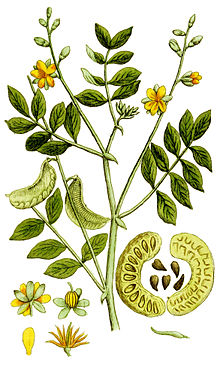
| |
| Senna alexandrina | |
| Scientific classification | |
| Kingdom: | Plantae |
| Clade: | Tracheophytes |
| Clade: | Angiosperms |
| Clade: | Eudicots |
| Clade: | Rosids |
| Order: | Fabales |
| Family: | Fabaceae |
| Subfamily: | Caesalpinioideae |
| Tribe: | Cassieae |
| Genus: | Senna Mill. |
| Type species | |
| Senna alexandrina | |
| Species | |
|
Over 300; see § Species | |
| Synonyms[1] | |
|
List
| |
Senna, the sennas, is a large genus of flowering plants in the legume family (Fabaceae, subfamily Caesalpinioideae,[2] tribe Cassieae ser. Aphyllae [3]). This diverse genus is native throughout the tropics, with a small number of species in temperate regions. The number of species is estimated to be from about 260[4] to 350.[5] The type species for the genus is Senna alexandrina. About 50 species of Senna are known in cultivation.[6]
Description
[edit]Plants in the genus Senna are shrubs, sometimes small trees or perennial herbs. The leaves are arranged alternately, paripinnate with up to 25 pairs of leaflets, each leaf with a stipule at the base, but that often falls off as the leaves mature. The flowers are arranged in racemes in leaf axils with bracts at the base. The flower has five egg-shaped green or yellowish sepals and five usually yellow, usually glabrous petals. There are usually ten stamens that are free from each other, the filaments of different lengths, and some are staminodes. The fruit is a leathery pod containing several seeds.[7][8][9][10]
Taxonomy and systematics
[edit]Chamaecrista, Cassia, and Senna form a monophyletic group which some authors have called Cassia sensu lato.[11] In 1982, the group was named Cassiinae and classified as a subtribe of the tribe Cassieae.[12] The tribe Cassieae contains 21 genera and is now known to be polyphyletic,[11] but the classification is still accepted because a revision of Fabaceae has yet to be published.[11]
The genus Senna has had a complex taxonomic history.[13] What is now known as Senna was included by Linnaeus in his concept of Cassia in Species Plantarum in 1753.[14] Philip Miller segregated Senna from Cassia in 1754 in the fourth edition of The Gardeners Dictionary.[15] Until 1982, many authors, following Linnaeus, did not recognize Senna and Chamaecrista, but included them in a broadly circumscribed Cassia sensu lato. Phylogenetic analyses of DNA have shown that Chamaecrista, Cassia, and Senna are all monophyletic, but the relationships between these three genera have not been resolved.[4] They are therefore shown in phylogenetic trees as a tritomy.
A fossil seed pod of a Senna sp. from the middle Eocene epoch has been described from the Rancho clay pit in Henry County, Tennessee, United States.[16]
Etymology
[edit]The genus name derives from the Arabic sanā, describing plants whose leaves and pods have cathartic and laxative properties.[17]
Species
[edit]As of July 2024[update], Plants of the World Online accepted the following species:[18]




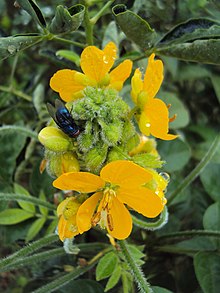
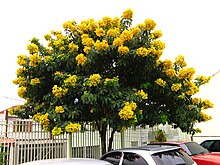
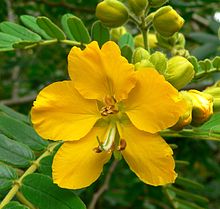

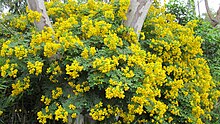
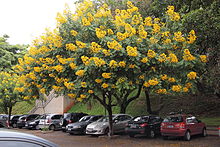
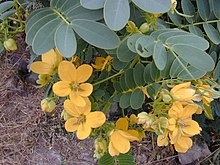
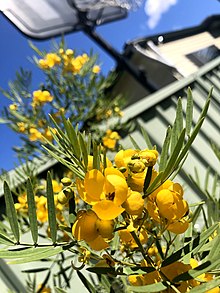
- Senna acanthoclada (Griseb.) H.S.Irwin & Barneby
- Senna acatlanensis C.Rojas-Mart. & A.Delgado
- Senna acclinis (F.Muell.) Randell – rainforest cassia, brush senna (New South Wales)
- Senna aciphylla (Benth. ex A.Gray) Randell – sprawling senna, Australian senna (eastern Australia)
- Senna aculeata (Pohl ex Benth.) H.S.Irwin & Barneby
- Senna acunae (Borhidi) A.Barreto & Yakovlev
- Senna acuparata H.S.Irwin & Barneby
- Senna acuruensis (Benth.) H.S.Irwin & Barneby
- Senna acutisepala (Benth.) H.S.Irwin & Barneby
- Senna affinis (Benth.) H.S.Irwin & Barneby
- Senna alata (L.) Roxb. – candlebush, Christmas candle
- Senna alexandrina Mill. – Alexandrian senna
- Senna andrieuxii (Benth.) H.S.Irwin & Barneby
- Senna angulata (Vogel) H.S.Irwin & Barneby
- Senna angustisiliqua (Lam.) H.S.Irwin & Barneby
- Senna ankaranensis Du Puy & R.Rabev.
- Senna anthoxantha (Capuron) Du Puy
- Senna aphylla (Cav.) H.S.Irwin & Barneby
- Senna apiculata (M.Martens & Galeotti) H.S.Irwin & Barneby
- Senna appendiculata (Vogel) Wiersema
- Senna apsidoneura (H.S.Irwin & Barneby) H.S.Irwin & Barneby
- Senna araucarietorum H.S.Irwin & Barneby
- Senna argentea (Kunth) H.S.Irwin & Barneby
- Senna arida (Rose) H.S.Irwin & Barneby
- Senna aristeguietae H.S.Irwin & Barneby
- Senna armata (S.Watson) H.S.Irwin & Barneby
- Senna arnottiana (Gillies) H.S.Irwin & Barneby
- Senna artemisioides (Gaudich. ex DC.) Randell – silver cassia (Australia)
- Senna atomaria (L.) H.S.Irwin & Barneby
- Senna aurantia (Ruiz & Pav. ex G.Don) H.S.Irwin & Barneby
- Senna auriculata (L.) Roxb. – avaram, Matara-tea, tanner's cassia
- Senna aversiflora (Herb.) H.S.Irwin & Barneby
- Senna aymara H.S.Irwin & Barneby
- Senna baccarinii (Chiov.) Lock
- Senna bacillaris (L.f.) H.S.Irwin & Barneby – West Indian showertree
- Senna bahiensis A.G.Lima & V.C.Souza
- Senna barclayana (Sweet) Randell – smooth senna, pepper-leaf senna (eastern Australia)
- Senna barnebyana Lass.
- Senna barronfieldii (Colla) Hewson – southern cassia (eastern Australia)
- Senna bauhinioides (A.Gray) H.S.Irwin & Barneby
- Senna benitoensis (Britton & P.Wilson) H.S.Irwin & Barneby
- Senna bicapsularis (L.) Roxb. – rambling senna, Christmas bush, money bush, yellow candlewood
- Senna biglandularis A.O.Araujo & V.C.Souza
- Senna birostris (Dombey ex Vogel) H.S.Irwin & Barneby
- Senna bosseri Du Puy & R.Rabev.
- Senna bracteosa D.B.O.S.Cardoso & L.P.Queiroz
- Senna brongniartii (Gaudich.) H.S.Irwin & Barneby
- Senna burkartiana (Villa) H.S.Irwin & Barneby
- Senna cajamarcae H.S.Irwin & Barneby
- Senna cana (Nees & Mart.) H.S.Irwin & Barneby
- Senna candolleana (Vogel) H.S.Irwin & Barneby
- Senna cardiosperma (F.Muell.) Randell (western Australia)
- Senna catingae (Harms) L.P.Queiroz
- Senna caudata (Standl.) H.S.Irwin & Barneby
- Senna cearensis Afr.Fern.
- Senna centranthera H.S.Irwin & Barneby
- Senna cernua (Balb.) H.S.Irwin & Barneby
- Senna charlesiana (Symon) Randell (Western Australia)
- Senna chloroclada (Harms) H.S.Irwin & Barneby
- Senna chrysocarpa (Desv.) H.S.Irwin & Barneby
- Senna circinnata (Benth.) Randell – coiled senna (eastern Australia)
- Senna cladophylla (W.Fitzg.) Randell (northern Australia)
- Senna clavigera (Domin) Randell – pepper leaf senna (eastern Australia)
- Senna cobanensis (Britton) H.S.Irwin & Barneby
- Senna coimbrae M.Nee & Barneby
- Senna collicola H.S.Irwin & Barneby
- Senna confinis (Greene) H.S.Irwin & Barneby
- Senna corifolia (Benth.) H.S.Irwin & Barneby
- Senna cornigera H.S.Irwin & Barneby
- Senna coronilloides (Benth.) Randell – brigalow senna (eastern Australia)
- Senna corymbosa (Lam.) H.S.Irwin & Barneby – Argentine senna, Argentine wild sensitive plant
- Senna costata (J.F.Bailey & C.T.White) Randell (northern Australia)
- Senna covesii (A.Gray) H.S.Irwin & Barneby – Coues' cassia, Coves' cassia, desert senna
- Senna crassiramea (Benth.) H.S.Irwin & Barneby
- Senna crotalarioides (Kunth) H.S.Irwin & Barneby
- Senna cruckshanksii (Hook. & Arn.) H.S.Irwin & Barneby
- Senna cuatrecasasii H.S.Irwin & Barneby
- Senna cumingii (Hook. & Arn.) H.S.Irwin & Barneby
- Senna curvistyla (J.M.Black) Randell (north-western Australia)
- Senna cushina (J.F.Macbr.) H.S.Irwin & Barneby
- Senna cuthbertsonii (F.Muell.) Randell (northern Western Australia)
- Senna dardanoi Afr.Fern. & P.Bezerra
- Senna dariensis (Britton & Rose) H.S.Irwin & Barneby
- Senna davidsonii (V.Singh) V.Singh
- Senna demissa (Rose) H.S.Irwin & Barneby
- Senna didymobotrya (Fresen.) H.S.Irwin & Barneby – candelabra-tree, peanut butter cassia, African senna
- Senna divaricata (Nees & Blume) Lock
- Senna divaricata (Nees & Blume) Lock
- Senna domingensis (Spreng.) H.S.Irwin & Barneby
- Senna dryadica A.G.Lima & Mansano
- Senna durangensis (Rose) H.S.Irwin & Barneby
- Senna ellisiae (Brenan) Lock
- Senna ferraria (Symon) Randell (north-western Western Australia)
- Senna flexuosa (Randell) Randell (Western Australia)
- Senna × floribunda (Cav.) H.S.Irwin & Barneby
- Senna foetidissima (Ruiz & Pav. ex G.Don) H.S.Irwin & Barneby
- Senna formosa H.S.Irwin & Barneby
- Senna franciscana A.G.Lima & Mansano
- Senna fruticosa (Mill.) H.S.Irwin & Barneby
- Senna galeottiana (M.Martens) H.S.Irwin & Barneby
- Senna gardneri (Benth.) H.S.Irwin & Barneby
- Senna garrettiana (Craib) H.S.Irwin & Barneby
- Senna gaudichaudii (Hook. & Arn.) H.S.Irwin & Barneby – climbing cassia, heuhiuhi (Pacific Islands, Queensland)
- Senna georgica H.S.Irwin & Barneby
- Senna glaucifolia (Randell) Randell (north-western Australia)
- Senna gloriosa (H.S.Irwin & Barneby) A.G.Lima & Mansano
- Senna glutinosa (DC.) Randell (Australia)
- Senna goniodes (A.Cunn. ex Benth.) Randell (northern Western Australia)
- Senna gossweileri (Baker f.) Lock
- Senna guatemalensis (Donn.Sm.) H.S.Irwin & Barneby
- Senna gundlachii (Urb.) H.S.Irwin & Barneby
- Senna hamersleyensis (Symon) Randell – creeping senna (northern Western Australia)
- Senna harleyi H.S.Irwin & Barneby
- Senna haughtii (J.F.Macbr.) H.S.Irwin & Barneby
- Senna hayesiana (Britton & Rose) H.S.Irwin & Barneby
- Senna hebecarpa (Fernald) H.S.Irwin & Barneby – American senna, wild senna
- Senna heptanthera Randell (Arnhem Land)
- Senna herzogii (Harms) H.S.Irwin & Barneby
- Senna hilariana (Benth.) H.S.Irwin & Barneby
- Senna hirsuta (L.) H.S.Irwin & Barneby – woolly senna (native to Americas, introduced elsewhere)
- Senna holosericea (Fresen.) Greuter
- Senna holwayana (Rose) H.S.Irwin & Barneby
- Senna hookeriana Batke
- Senna huancabambae (Harms) H.S.Irwin & Barneby
- Senna huidobriana (Phil.) Zoellner & San Martin
- Senna huilana (Britton & Rose) H.S.Irwin & Barneby
- Senna humifusa (Brenan) Lock
- Senna incarnata (Pav. ex Benth.) H.S.Irwin & Barneby
- Senna insularis (Britton & Rose) H.S.Irwin & Barneby
- Senna intermedia (B.D.Sharma, Vivek. & Rathakr.) V.Singh
- Senna italica Mill. – Port Royal senna, dog senna, Italian senna, Spanish senna
- Senna itatiaiae H.S.Irwin & Barneby
- Senna juchitanensis Saynes & R.Torres
- Senna koelziana H.S.Irwin & Barneby
- Senna kuhlmannii Hoehne
- Senna kurtzii (Harms) H.S.Irwin & Barneby
- Senna lactea (Vatke) Du Puy
- Senna lasseigniana H.S.Irwin & Barneby
- Senna latifolia (G.Mey.) H.S.Irwin & Barneby
- Senna leandrii (Ghesq.) Du Puy
- Senna lechriosperma H.S.Irwin & Barneby
- Senna leiophylla (Vogel) H.S.Irwin & Barneby
- Senna leptoclada (Benth.) Randell (Northern Territory)
- Senna ligustrina (L.) H.S.Irwin & Barneby – privet senna
- Senna lindheimeriana (Scheele) H.S.Irwin & Barneby – velvet-leaf senna, showy senna
- Senna longiglandulosa (Benth.) H.S.Irwin & Barneby
- Senna longiracemosa (Vatke) Lock
- Senna loretensis (Killip & J.F.Macbr.) H.S.Irwin & Barneby
- Senna lourteigiana H.S.Irwin & Barneby
- Senna macranthera (DC. ex Collad.) H.S.Irwin & Barneby
- Senna macrophylla (Kunth) H.S.Irwin & Barneby
- Senna magnifolia (F.Muell.) Randell (Western Australia)
- Senna malaspinae H.S.Irwin & Barneby
- Senna mandonii (Benth.) H.S.Irwin & Barneby
- Senna manicula (Symon) Randell (Western Australia)
- Senna marilandica (L.) Link
- Senna martiana (Benth.) H.S.Irwin & Barneby
- Senna mensicola (H.S.Irwin & Barneby) H.S.Irwin & Barneby
- Senna meridionalis (R.Vig.) Du Puy – Madagascar senna
- Senna mexicana (Jacq.) H.S.Irwin & Barneby – Mexican senna
- Senna mollissima (Humb. & Bonpl. ex Willd.) H.S.Irwin & Barneby
- Senna monilifera H.S.Irwin & Barneby
- Senna monozyx (H.S.Irwin & Barneby) H.S.Irwin & Barneby
- Senna montana (B.Heyne ex Roth) V.Singh
- Senna morongii (Britton) H.S.Irwin & Barneby
- Senna mucronifera (Mart. ex Benth.) H.S.Irwin & Barneby
- Senna multifoliolata (Paul G.Wilson) H.S.Irwin & Barneby
- Senna multiglandulosa (Jacq.) H.S.Irwin & Barneby – glandular senna, downy senna (Central and Southern America, introduced elsewhere)
- Senna multijuga (Rich.) H.S.Irwin & Barneby – November shower, false sicklepod (Central and Southern America, introduced elsewhere)
- Senna mutisiana (Kunth) H.S.Irwin & Barneby
- Senna nana (Benth.) H.S.Irwin & Barneby
- Senna neglecta (Vogel) H.S.Irwin & Barneby
- Senna nicaraguensis (Benth.) H.S.Irwin & Barneby
- Senna nitida (Rich.) H.S.Irwin & Barneby
- Senna notabilis (F.Muell.) Randell – cockroach bush (Australia)
- Senna nudicaulis (Burkart) H.S.Irwin & Barneby
- Senna obliqua (G.Don) H.S.Irwin & Barneby (Peru)
- Senna oblongifolia (Vogel) H.S.Irwin & Barneby
- Senna obtusifolia (L.) H.S.Irwin & Barneby – coffee-weed, java-bean, American sicklepod (Central and Southern America, introduced elsewhere)
- Senna occidentalis (L.) Link – coffee senna, styptic weed, septicweed (U.S.A., Central and Southern America, introduced elsewhere)
- Senna oligoclada (F.Muell.) Randell (Northern Australia)
- Senna orcuttii (Britton & Rose) H.S.Irwin & Barneby – Orcutt's senna
- Senna organensis (Glaz. ex Harms) H.S.Irwin & Barneby
- Senna oxyphylla (Kunth) H.S.Irwin & Barneby
- Senna pachyrrhiza (L.Bravo) H.S.Irwin & Barneby
- Senna pallida (Vahl) H.S.Irwin & Barneby
- Senna papillosa (Britton & Rose) H.S.Irwin & Barneby
- Senna paposana (Phil.) Zoellner & San Martin
- Senna paradictyon (Vogel) H.S.Irwin & Barneby
- Senna paraensis (Ducke) H.S.Irwin & Barneby
- Senna pendula (Humb. & Bonpl. ex Willd.) H.S.Irwin & Barneby – Easter cassia
- Senna pentagonia (Mill.) H.S.Irwin & Barneby
- Senna peralteana (Kunth) H.S.Irwin & Barneby
- Senna perrieri (R.Vig.) Du Puy
- Senna petersiana (Bolle) Lock
- Senna phlebadenia H.S.Irwin & Barneby
- Senna phyllodinea (R.Br.) Symon (arid areas of Australia)
- Senna pilifera (Vogel) H.S.Irwin & Barneby
- Senna pilocarina (Symon) Randell (Western Australia)
- Senna pilosior (B.L.Rob.) H.S.Irwin & Barneby — Trans-Pecos senna
- Senna pinheiroi H.S.Irwin & Barneby
- Senna pistaciifolia (Kunth) H.S.Irwin & Barneby
- Senna planitiicola (Domin) Randell
- Senna pleurocarpa (F.Muell.) Randell – stripe-pod cassia
- Senna pluribracteata F.S.Souto & R.T.Queiroz
- Senna pneumatica H.S.Irwin & Barneby
- Senna podocarpa (Guill. & Perr.) Lock
- Senna polyantha (Collad.) H.S.Irwin & Barneby
- Senna polyphylla (Jacq.) H.S.Irwin & Barneby
- Senna praeterita H.S.Irwin & Barneby
- Senna procumbens Randell
- Senna pumilio (A.Gray) H.S.Irwin & Barneby – dwarf senna
- Senna punoensis Lass.
- Senna purpusii (Brandegee) H.S.Irwin & Barneby
- Senna quinquangulata (Rich.) H.S.Irwin & Barneby
- Senna racemosa (Mill.) H.S.Irwin & Barneby – limestone senna
- Senna reniformis (G.Don) H.S.Irwin & Barneby
- Senna reticulata (Willd.) H.S.Irwin & Barneby
- Senna rigidicaulis (Burkart ex L.Bravo) H.S.Irwin & Barneby
- Senna ripleyana (H.S.Irwin & Barneby) H.S.Irwin & Barneby – Ripley's senna
- Senna rizzinii H.S.Irwin & Barneby
- Senna robiniifolia (Benth.) H.S.Irwin & Barneby
- Senna roemeriana (Scheele) H.S.Irwin & Barneby – twoleaf senna, Roemer senna
- Senna rostrata (Mart.) H.S.Irwin & Barneby – New Mexico wild sensitive plant
- Senna rugosa (G.Don) H.S.Irwin & Barneby
- Senna ruiziana (G.Don) H.S.Irwin & Barneby
- Senna rupununiensis H.S.Irwin & Barneby
- Senna ruspolii (Chiov.) Lock
- Senna saeri (Pittier) H.S.Irwin & Barneby
- Senna sandwithiana H.S.Irwin & Barneby
- Senna santanderensis (Britton & Killip) H.S.Irwin & Barneby
- Senna scabriuscula (Vogel) H.S.Irwin & Barneby
- Senna scandens (Ruiz & Pav. ex G.Don) H.S.Irwin & Barneby
- Senna septemtrionalis (Viv.) H.S.Irwin & Barneby – arsenic-bush, dooleyweed, laburnum, smooth senna
- Senna sericea (Symon) Albr. & Symon
- Senna siamea (Lam.) H.S.Irwin & Barneby – kassodtree, Siamese cassia, Thai cassia, Thailand shower
- Senna silvestris (Vell.) H.S.Irwin & Barneby
- Senna singueana (Delile) Lock
- Senna skinneri (Benth.) H.S.Irwin & Barneby
- Senna smithiana (Britton & Rose) H.S.Irwin & Barneby
- Senna sophera (L.) Roxb.
- Senna sousana H.S.Irwin & Barneby
- Senna spectabilis (DC.) H.S.Irwin & Barneby
- Senna spinescens (Hoffmanns. ex Vogel) H.S.Irwin & Barneby
- Senna spiniflora (Burkart) H.S.Irwin & Barneby
- Senna spinigera (Rizzini) H.S.Irwin & Barneby
- Senna splendida (Vogel) H.S.Irwin & Barneby
- Senna stenophylla (Britton) H.S.Irwin & Barneby
- Senna stipulacea (W.T.Aiton) H.S.Irwin & Barneby
- Senna stowardii (S.Moore) Randell
- Senna stricta (Randell) Randell
- Senna suarezensis (Capuron) Du Puy
- Senna subtrijuga H.S.Irwin & Barneby
- Senna subulata (Griseb.) H.S.Irwin & Barneby
- Senna sulfurea (DC. ex Collad.) H.S.Irwin & Barneby
- Senna surattensis (Burm.f.) H.S.Irwin & Barneby
- Senna symonii (Randell) Randell
- Senna talpana H.S.Irwin & Barneby
- Senna tapajozensis (Ducke) H.S.Irwin & Barneby
- Senna tenuifolia (Vogel) H.S.Irwin & Barneby
- Senna timoriensis (DC.) H.S.Irwin & Barneby
- Senna tocotana (Rose ex Britton & Killip) Silverst.
- Senna tonduzii (Standl.) H.S.Irwin & Barneby
- Senna tora (L.) Roxb. – sickle senna, foetid cassia
- Senna trachypus (Mart. ex Benth.) H.S.Irwin & Barneby
- Senna trianae H.S.Irwin & Barneby
- Senna trolliiflora H.S.Irwin & Barneby
- Senna tropica (Vell.) H.S.Irwin & Barneby
- Senna truncata (Brenan) Lock
- Senna tuhovalyana (Aké Assi) Lock
- Senna uncata H.S.Irwin & Barneby
- Senna undulata (Benth.) H.S.Irwin & Barneby
- Senna uniflora (Mill.) H.S.Irwin & Barneby
- Senna unijuga (Rose) H.S.Irwin & Barneby
- Senna urmenetae (Phil.) H.S.Irwin & Barneby
- Senna vargasii (Schery) H.S.Irwin & Barneby
- Senna velutina (Vogel) H.S.Irwin & Barneby
- Senna venusta (F.Muell.) Randell
- Senna versicolor (Meyen ex Vogel) H.S.Irwin & Barneby
- Senna viarum (Little) H.S.Irwin & Barneby
- Senna viciifolia (Benth.) H.S.Irwin & Barneby
- Senna viguierella (Ghesq.) Du Puy
- Senna villosa (Mill.) H.S.Irwin & Barneby
- Senna viminea (L.) H.S.Irwin & Barneby
- Senna weddelliana H.S.Irwin & Barneby
- Senna williamsii (Britton & Rose) H.S.Irwin & Barneby
- Senna wislizeni (A.Gray) H.S.Irwin & Barneby
- Senna wurdackii H.S.Irwin & Barneby – Wislizenus' senna, shrubby senna
Ecology
[edit]The caterpillars of many species feed on Senna plants. The black witch (Ascalapha odorata), two-barred flasher (Astraptes fulgerator), common emigrant (Catopsilia pomona), and mottled emigrant (C. pyranthe) have all been recorded on candle bush (S. alata), for example.
Some species have extrafloral nectaries on the leaves or flower stalks that are visited by ants.[4]
Pollination
[edit]Senna species are pollinated by a variety of bees, especially large female bees in genera such as Xylocopa.[4] They rely on "buzz pollination" and some within that on "ricochet pollination", which is a secondary pollen presentation where the pollen is not deposited on the pollinator's body by direct contact with the anthers.[19] The flowers have two sets of stamen: feeding stamens, which are longer, and pollinating stamens, which are smaller in size.[20] Due to buzz pollination, the pollens from the pollinating stamens get thrown from the anthers and ricochets against the petals multiple times before it settles on the dorsal side of the pollinating bee. The roughness on the petal walls causes the pollen to slow down its speed. The ricocheting effect alone cannot ensure effective pollen dissemination. It is aided by static charges wherein the flying bees become positively charged owing to the friction in the air and the pollen becomes negatively charged because of which they naturally get attracted to the bee's body. The pollinator bee ends up carrying the pollen and also gets to feed on the pollen which is on the feeding stamens.[19]
Uses
[edit]Some Senna species are used as ornamental plants in landscaping. The genus is adapted to many climate types.
Cassia gum, an extract of the seeds of Chinese senna (S. obtusifolia), is used as a thickening agent. The leaves and flowers of Siamese cassia (S. siamea) are used in some Southeast Asian cuisines, such as Thai, Shan/Burmese and Lao cuisines. They are known as khi-lek in Thai, and are used in curries.[21]
Laxative
[edit]Senna is considered[who?] to be a bowel stimulant on the myenteric plexus of the colon to induce peristaltic contractions and decrease water absorption from inside the colon, effects that would provide relief from constipation.[22] The laxative syrup of figs gets most of its effect from the presence of senna.[23]
Plants in the Senna genus have been studied for their beneficial effects arising from the abundance of phytochemicals, bioactive components and antioxidant and antimicrobial properties.[3]
Senna or its extracted sennosides, alone or in combination with sorbitol or lactulose, have been evaluated in systematic reviews and Cochrane reviews for treatment of constipation in children and the elderly. Some studies showed limited evidence for efficacy,[24][25][26] whereas others indicated the study designs were too weak to be certain of senna having utility as a laxative.[22][27][28]
References
[edit]- ^ Irwin HS, Barneby RC (1982). The American Cassiinae: A synoptical revision of Leguminosae tribe Cassieae subtribe Casiinae in the New World, Part 1 (PDF). Bronx, N.Y.: New York Botanical Garden. OCLC 8553234. b1010840.
- ^ The Legume Phylogeny Working Group (LPWG) (2017). "A new subfamily classification of the Leguminosae based on a taxonomically comprehensive phylogeny". Taxon. 66 (1): 44–77. doi:10.12705/661.3. hdl:10568/90658.
- ^ a b Alshehri, Mohammed M.; Quispe, Cristina; Herrera-Bravo, Jesús; Sharifi-Rad, Javad; Tutuncu, Sena; Aydar, Elif Feyza; Topkaya, Cansu; Mertdinc, Zehra; Ozcelik, Beraat; Aital, Mahima; Kumar, N. V. Anil; Lapava, Natallia; Rajkovic, Jovana; Ertani, Andrea; Nicola, Silvana (2022-02-04). "A Review of Recent Studies on the Antioxidant and Anti-Infectious Properties of Senna Plants". Oxidative Medicine and Cellular Longevity. 2022: e6025900. doi:10.1155/2022/6025900. ISSN 1942-0900. PMC 8837466. PMID 35154569.
- ^ a b c d Marazzi, B.; et al. (2006). "Phylogenetic relationships within Senna (Leguminosae, Cassiinae) based on three chloroplast DNA regions: patterns in the evolution of floral symmetry and extrafloral nectaries". American Journal of Botany. 93 (2): 288–303. doi:10.3732/ajb.93.2.288. PMID 21646190. S2CID 24791422.
- ^ Randell, B. R. and B. A. Barlow. 1998. Senna. pp 89-138. In: A. S. George (executive editor). Flora of Australia volume 12. Australian Government Publishing Service: Canberra, Australia.
- ^ Huxley, A., et al. (1992). The New Royal Horticultural Society Dictionary of Gardening. The Macmillan Press, Limited: London. The Stockton Press: New York. ISBN 978-0-333-47494-5 (set).
- ^ "Senna". Australian Biological Resources Study, Department of Agriculture, Water and the Environment: Canberra. Retrieved 3 June 2023.
- ^ Jeanes, Jeff A.; Stajsic, Val. "Senna". Royal Botanic Gardens Victoria. Retrieved 3 June 2023.
- ^ Wiecek, Barbara. "Senna". Royal Botanic Garden Sydney. Retrieved 3 June 2023.
- ^ "Senna". Flora of China. Retrieved 3 June 2023.
- ^ a b c Lewis, G., et al. 2005. Legumes of the World. Royal Botanic Gardens, Kew: Richmond, England. ISBN 978-1-900347-80-8
- ^ Irwin H. S., Barneby R. C. (1982). "The American Cassiinae: A synoptical revision of Leguminosae tribe Cassieae subtribe Cassiinae in the New World". Memoirs of the New York Botanical Garden. 35: 1–119.
- ^ Singh, V. 2001. Monograph on the Indian Subtribe Cassiinae. Scientific Publishers (India): Jodhpur, India.
- ^ Linnaeus, C. 1753. Cassia. page 376. In: Species Plantarum volume 1. Cassia (including Senna) In:Species Plantarum volume 1 At: Biodiversity Heritage Library
- ^ Miller, P. 1754. The Gardeners Dictionary, Abridged 4th edition.
- ^ The Fossil History of Leguminosae from the Eocene of Southeastern North America by Patrick S. Herendeen, Advances in Legume Systematics: Part 4, The Fossil Record, Ed. P. S. Herendeen & Dilcher, 1992, The Royal Botanic Gardens, Kew, ISBN 0 947643 40 0
- ^ "Senna". Australian Biological Resources Study, Department of Agriculture, Water and the Environment: Canberra. Retrieved 1 June 2023.
- ^ "Senna". Plants of the World Online. Retrieved 1 June 2023.
- ^ a b Bir Bahadur (2019). Asymmetry in Plants: Biology of Handedness. CRC Press. ISBN 9780429960710.
- ^ Bruna Karen Pinheiro-Costa, José Neiva Mesquita-Neto, Juliana Ordones Rego, Clemens Schlindwein; et al. (2018). "Trade off between quantity and size of pollen grains in the heterandrous flowers of Senna pendula (Fabaceae)". Acta Botanica Brasilica. 32 (3): 446–453. doi:10.1590/0102-33062018abb0132.
{{cite journal}}: CS1 maint: multiple names: authors list (link) - ^ Teangpook C.; et al. (2011). "Production and nutrition of Khi Lek (Siamese cassia) curry from central Thailand" (PDF). Kasetsart. J. (Nat. Sci.). 45: 510–20. Archived from the original (PDF) on 2016-03-04. Retrieved 2013-08-29.
- ^ a b Leung, L; Riutta, T; Kotecha, J; Rosser, W (2011). "Chronic constipation: An evidence-based review". The Journal of the American Board of Family Medicine. 24 (4): 436–51. doi:10.3122/jabfm.2011.04.100272. PMID 21737769.
- ^ Lockhart, Bill; Schriever, Beau. "California Fig Syrup: The Company and Its Bottles" (PDF). Society for Historical Archaeology. Retrieved 2022-01-01.
- ^ Mueller-Lissner, S. A.; Wald, A (2010). "Constipation in adults". BMJ Clinical Evidence. 2010: 0413. PMC 3217654. PMID 21418672.
- ^ Wald, A (2016). "Constipation: Advances in Diagnosis and Treatment". JAMA. 315 (2): 185–91. doi:10.1001/jama.2015.16994. PMID 26757467.
- ^ Izzy, M; Malieckal, A; Little, E; Anand, S (2016). "Review of efficacy and safety of laxatives use in geriatrics". World Journal of Gastrointestinal Pharmacology and Therapeutics. 7 (2): 334–342. doi:10.4292/wjgpt.v7.i2.334. PMC 4848256. PMID 27158549.
- ^ CADTH Rapid Response Reports (2014). "Treatments for Constipation: A Review of Systematic Reviews". Canadian Agency for Drugs and Technologies in Health. CADTH Rapid Response Reports. PMID 25535635.
- ^ Gordon, M; MacDonald, J. K.; Parker, C. E.; Akobeng, A. K.; Thomas, A. G. (2016). "Osmotic and stimulant laxatives for the management of childhood constipation". The Cochrane Database of Systematic Reviews. 2018 (8): CD009118. doi:10.1002/14651858.CD009118.pub3. PMC 6513425. PMID 27531591.
